
Construction for the new airport (airport code: OSA/RJBE) was started in September of 2004 by the city of Kobe and was completed in December of 2005. The airport with a 2500m runway is approximately 8 kilometers from Sannomiya and was built in the open sea on a manmade island (272 hectares) south of Port Island. A new transportation system (Port liner) connects the airport to the Kobe urban district.
To ensure that airplane routes using the Kansai and Itami airports don't overlap, flights will land and takeoff from the west toward the straits of Akashi. 2.7 million people are expected to use the airport in its first year with the number increasing to 4 million in 2010.
On November 29th, 2005, Japan Air Lines, All Nippon Airways, and Skymark Airlines applied to the Transportation Ministry for flight timetables for arrival and departure routes at the Kobe Airport. (February 16th to March 15th, 2006). Because of this, quantity of routes and timetable after opening were decided with seven routes and 27 roundtrip flights: Haneda having 11 roundtrip flights, Naha and Kagoshima each have 4 roundtrip flights, and Sapporo (Shin-Chitose) has 3 roundtrip flights. Reservations for flights began being taken from December 16th of last year.
Three-story steel frame (four-story in one part) with a deck area of approximately 15,200u (excluding detached buildings such as the power building)
1) 1st Floor (Arrivals)
Lobby for arrivals (Information counter, exhibition space, etc.)
Baggage claim (two belt conveyors for arrivals)
Baggage check (3 belt conveyors for departures)
Airline Offices (JAL, ANA, and Skymark)
Tenant (convenience store)
Airport Security Office
2) 2nd Floor (Departures)
Departures lobby
Embarkation counters (2 counters)
Departure door, security check area (metal detectors)
Embarkation waiting room (approx. 800 seats)
Embarkation catwalks at 3 location
Tenant (18 retail stores selling such products as Kobe confectionary, Nada Sake/Kobe Wine, and other local specialty items.
Special waiting room
3) 3rd floor (restaurants)
Tenant (6 restaurants for dining and coffee
Light coat (passage to upper level)
4) Upper level deck (a partial 4th floor)
Restaurants with scenic views, coffee shop, rooftop garden, and send off deck
a) Compact and easy-to-use terminal
b) Flow separation of people arriving and departing.
c) Access flow at time of embarking is short: direct connection to Portliner or new traffic system by a connecting passage approximately 10m from the 2nd floor.
d) Facilities with universal design: equipment such as corresponding to ostomy and baby bed; multi-function toilet and audio guide system
e) Upper level deck: panoramic night view of Mt. Rokko and the Kobe urban district from the sea.
From in front of the airport terminal to Arima Onsen, by a transport bus that carries about 22 people, it takes about an hour and goes directly to Arima Onsen. Fare and timetables are not yet set, but in celebration of the airport opening, transportation is free from February 16th to April 30th.
![]()
Recently the new transportation system (Port liner) was extended to the island of Kobe Airport. From the 2nd floor of airport terminal takes only 16 minutes. Furthermore from Sannomiya to Arima it takes about 35 minutes by combination of subway and Kobe Railway.

Use the large-scale parking lot at the north side of the airport terminal. A motorway connects the airport island to the Kobe urban district in about ten minutes. After crossing "Kobe Sky Bridge" connecting to Port Island, signs for Kobe Ohashi Bridge or underwater Minatojima Tunnel will appear for reaching Sannomiya. From Sannomiya, travel about 25 minutes to Arima using the new Kobe tunnel and the Hanshin Expressway.


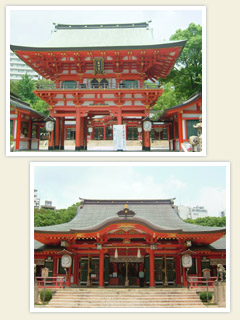
Located north of the Sannomiya stations of JR and Hankyu Railways, Ikuta Shrine can be found cloaked within the bustling city streets. In the year 201, Empress Jingu Kogo (the wife of the 14th generation Emperor Chuai) on a return trip from an expedition to Korean Peninsula had trouble with her sailing ship. She stopped in Kobe along the way where she received an oracle to pray for Wakahirume no Mikoto, the childhood name of legendary goddess Amaterasu and the name of her younger sister. Steeped with a history extending over 1800 years, Ikuta Shrine continues to honor Wakahirume no Mikoto. It is said that the name Kobe comes from an ancient wealthy sponsor of this shrine, who was called Kambe, which later became Kobe.
Within the precincts of the shrine, there resides Owatatsumi Shrine, the chief shrine of the area. This is the shrine where mariners from all of Japan come to pray for protection on the sea. It is also the place where people pray for certain victory. Many professional baseball and J League soccer players often visit here to pray. Also, Benzaiten, one of the seven good fortune gods in Kobe, is worshipped here.
A monument for Kajiwara no Kagesue, a Genji warrior as well as a monument for a Noh song of Taira no Atsumori, a Heike warrior, are found within the grounds. In back of the shrine is the forest that was the battle site between the Heike and Genji clans in the late 12th century. The Genji clan won this battle through the heroic leadership of Minamoto no Yoshitsune.

If you exit the east exit of the Hankyu Sannomiya station and walk up the gentle slope (Kitano Hill) for about 15 minutes, you will reach Yamamoto Street. (alias "Western-style Houses). This street on the mountainside is a popular place for sightseeing, and there are many western-style houses built here.
Accompanying the opening of the Kobe Port in 1868, a foreign settlement area was created on the west side of the current city hall, but the number of foreigners coming to Japan quickly rose and there was a housing shortage. The west side of Mt. Rokko had a good view and became a popular residential place for foreigners. Actual construction started in the 1890s and more than 200 houses were built in only fifty years, more than 200 western-style houses were built and gave the landscape an exotic view.
Unfortunately, the vast majority of houses were destroyed either by World War II or by large earthquakes, leaving approximately 60 houses left of the original Western-styled houses. The area containing the Western-styled houses was designated as an "important historical restoration area" with 34 of the houses having been designated as an "important cultural assets of Japan" or "traditional building." Some of these houses are open to the public.
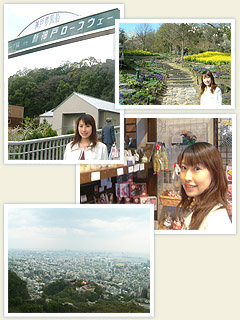
Built in the urban district of Kobe, the Nunobiki Herb Garden is an invigorating space that can be visited easily on the way to an appointment. It was opened in 1991 as a stage opening people to the world of taste, color and fragrance.
The station of the ropeway gondola called "Dream Balloon" can be reached in only a 5-minute walk west from the JR Shin Kobe station. When you arrive at the herb garden, you will be able to enjoy the beautiful scenery looking down on the Kobe urban district and harbor. With its rich green expanse spreading diagonally on the mountain, there are 150 types of herbs grown in the herb field. The garden has a glasshouse where you can experience the life with herbs, and Herb Garden Restaurant that boasts delicious food fully utilizing the herbs. There is also a shop with an assortment of herb goods and other items.
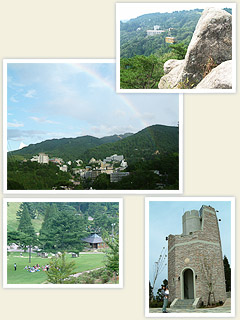
Located north of the line of cities of Takarazuka, Nishinomiya, AshiyaAand Kobe, the mountain range of Mt. Rokko stands like a partition extending 30km to the east and west at an altitude of 931m above sea level. In 1895, Kobe resident Arthur H. Groom, an English trader, happened upon the area on a hunting excursion and found the Mt. Rokko area to be an ideal place for a mountain cottage. He built a summerhouse on the edge of a pond popularly called Groom Pond, and development for health resorts quickly ensued. The vicinity around the top of Mt. Rokko is almost 10 degrees cooler than the urban district of Kobe. With Rokko Garden Terrace, Alpine Botanic Garden, Country House, Arboretum, Rokko Ranch, Field Athletic Center, and man-made ski slope, the area of Mt. Rokko has something for everyone which can be enjoyed by the family,.
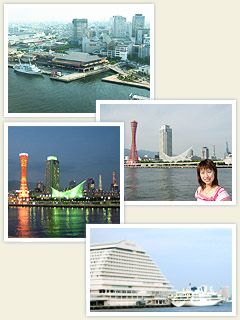
Cruises originating from Kobe Harbor offer spectacular views of Kobe with the towering mountain range of Mt. Rokko overlooking the Seto Inland Sea and extending along the coast like a folding screen. With its beautiful scenery, Kobe, a prosperous port city that served as a gateway to Kyushu and Mainland China almost 1000 years before, developed as a harbor for international trade after the Meiji Restoration and was a site for foreign settlements. Today, Kobe maintains its international atmosphere with many exotic sightseeing places teeming with multi-cultures from other countries. A variety of cruises are available from Kobe Harbor ranging in length from 30 minutes to more than 2 hours. Those taking the Akashi Kaikyo Bridge dinner cruise will be impressed with the incredible night view that appears like a glittering white pearl necklace floating on the dark sea.
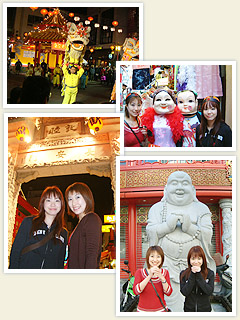
The birth of Nankin-machi is said to have begun with the opening of the Kobe port in 1867. At that time there were already a number of overseas living in the south area of Motomachi, and this caused businesses such as tailor shops, pork shops, Chinese medicine shops and restaurants to appear nearby. In the beginning of the 20th century, customers from all over Japan began coming to Nankinmachi for the wide range of products causing people to say, "You can find anything at Nankin-machi." Conditions suffered afterward with the bombing of Kobe during World War II and the subsequent destruction; however, in the 1980's, there was a Nankin-machi revival with the area being given a Chinese motif that can be seen today. The prosperity in the area has recovered due to the Chinese New Year's and Spring Welcoming Festival that have been increasingly gaining popularity nationwide.
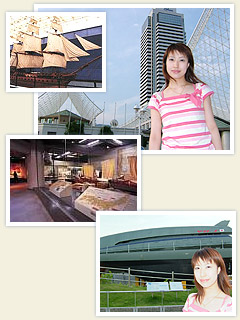
Commemorating the 120th anniversary of the opening of the Kobe Harbor is a comprehensive museum for "seas, ships, and ports" that is prominent around the world. Housed in a fashionable white building that has the unique appearance representing a sailing ship and waves, the building is perfectly suited for the Kobe Harbor. There are many exhibitions related to the sea and a corner introducing the history of the Kobe Harbor. There is a simulation of coming into port and many facilities that offer an enjoyable learning experience.
In the exhibition room there is the latest, state-of-the-art projection system with multiple screens and a 360-degree multiplex screen that give the feeling of being there that shouldn't be missed. Also, one place of particular interest is the "Present-day Pilot Cabin" with its realistic reproduction of a pilot cabin of a luxurious cruiser. Outside the museum, enthusiasts will not want to miss the actual super-conductivity electromagnetic propulsion boat "Yamoto 1," which is open to the public to show the ships of the future. For children there is a 3-D high definition television theater showing movies of doll dramas that are real crowd pleasers.
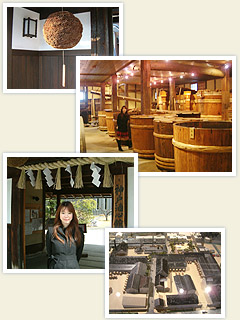
Along the coast are two areas known for brewing Japanese sake: the Kobe's Nada and Higashi-nada districts and Nishinomiya. From ancient times these areas have been called "Nada-gogo" and have thrived because of their sake breweries. Nada has six rivers that flow down from Mt. Rokko that were used to drive waterwheels used in rice milling. Also, Nada has some of the best sake brewing water in Japan, the famous "Miyamizu" rising up in wells after filtering through down from Mt. Rokko.
Even today visitors can find a number of sake warehouses with traditional architecture and sake museums. At sake materials museums and commemorative buildings, there are tasting corners for the sake connoisseur where you can taste the sake "fresh from the brewery" and "fresh production." In addition to Japanese sake, there are sake lees, amazake (sweet slightly alcoholic sake), rice crackers made from Yamadanishiki sake-type rice and other souvenirs that will suit nondrinkers. Some excellent goods are the dark blue happi coat and apron with an area left blank for the sake meister's name. Traditional methods of making sake and the workers candy are considered. Visiting this area is an enjoyable experience for people of all walks of life.
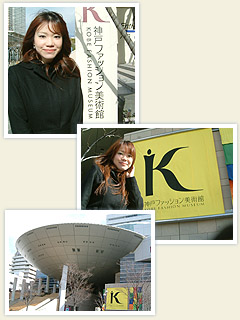
The JR Sumiyoshi station as well as the Hanshin Railway Uozaki stations can be used to access the new transportation system (Rokko Liner) that connects to the man-made island called Rokko Island. Much of the buildings are centered around the Kobe Fashion Plaza with its design symbolizing a futuristic city on the sea. The multi-functional complex includes RINK, a shopping mall and food court for relaxing and MOVIX Rokko, a movie theater for those with a deep appreciation of movies.
There is also the Kobe Fashion Museum, which is Japan's first fine arts museum devoted to fashion as a theme. It exhibits images, sounds, and lighting of Western clothing from the 18th century to the present and folk attire centered on Asia. In addition, there is a library with around 25,000 volumes of design-related books, CD-ROMs, and other resource materials that can be freely viewed.
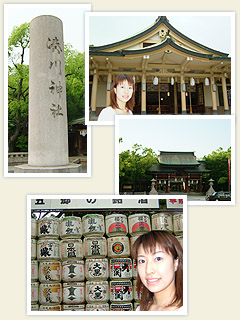
This shrine was dedicated to Kusunoki Masashige (Honorary title "Dai-Nanko"), a famous warrior who fell in the Battle of Minatogawa, Kobe in the 14th century.
Next in importance are his brother, Kusunoki Masasue, and other warriors of the family. Through the efforts of the first governor of Hyogo Prefecture Ito Hirobumi, the shrine was dedicated in 1872 at its present site and is affectionately referred to by the local people as "Nanko-san."
During the Hatsuuma Festival celebrating the Hatsuuma day (the first horse day) in February, visitors pray for peace and security of the nation and prosperity of venerated persons. Nanko Festival is held on May 25th, the anniversary of his death, the enshrined deity. On that day some people dress up in the costumes of Kusunoki Masashige and the 16 generals of his family and form a parade going through the streets. In the shrine there is the actual breastplate worn by Kusunoki Masashige that is an important cultural asset. There are other important items such as a sutra hand-written by Masashige and the works of Yokoyama Taikan and Maeda Seison. There are approximately 100 items of cultural assets related to Kusunoki Masashige stored in treasure museum of the shrine.
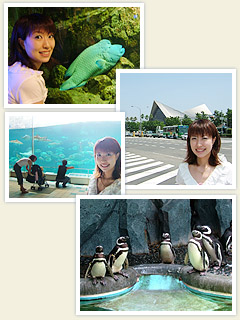
Next to the aquarium is the Suma Beach swimming area with an expansive park filled with greenery. This is not only a splendid environment for the ecology of marine life, but the facilities were built to allow close observation of marine live in an environment that is as natural as possible. Protruding from the 1st and 2nd floors of the main hall is a large tank. There is a transparent wall made of acrylic resin with a thickness of 210 mm where you can see such marine shark, stingrays, and sea turtles swimming along with sardines that have forming a group. With surges of water formed by the artificial wave maker, visitors get a feeling of the mighty deep of the Pacific Ocean. In addition there is Japan's first underwater tunnel called "Amazon museum." Here enormous fresh water fish from the Amazon River swim around you. Watch the spectacle of fish swimming above as you experience the feeling of walking underwater.
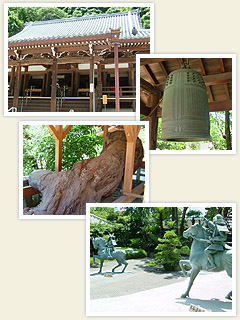
Sumadera Temple is a temple of the Shingon sect formally known as Fukushoji Temple and was founded in 886. This temple was dedicated to Kobo Daishi, the famous monk of the 8th-9th centuries. In addition to the important cultural assets of the Muromachi period (the 14th-16th centuries) such as the "palace" (inner sanctuary of the main hall), the family Buddhist altar, and Bodhisattva statues, there are many historical sites related to the Battle of Genji and Heike in the late 12th century remain. On the premises, in addition to the statue of Taira no Atsumori, a Heike warrior and Kumagai Naozane, a Genji warrior, hailing him, there are places of distinction: the "mound where Atsumori's head was buried," "the actual place where Atsumori sat for beheading", and "the place where his head was washed" The treasure room is open to the public free of charge with Atsumori's favorite flute of green leaves and a big bell brought by Benkei, a Genji warrior are on displayed. Lined in a row within the temple are 25 stone carvings of haiku composed by Yosa no Busan and Masaoka Shiki and waka or Japanese short verses, etc.
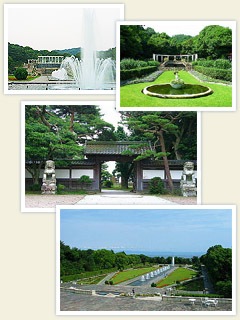
Suma Rikyu Park is a western style garden modeled after the Versailles Palace in Paris, France that sits in the remains of Muko Rikyu, a detached palace. It is the place where Arihara no Yukihira, a famous poet of the 9th century, hid in Suma and looked at the moon from an elevated place. At the end of1914, a building made completely of cypress was constructed at the place where he looked at the moon. The building was rebuilt in 1967 after being destroyed in the World War II. Renamed Suma Rikyu Park, the garden is opened to the public.
The garden is remarkable for its wide spacious park with a grassy field and a rose garden at its center, styled after the Versailles Palace in Paris. A big water fountain that shoots water with the ocean at Suma in the background. The fountain is lit up with seven-colored lights at night from July 20 through August 31. About 300 types of plum trees and hydrangea can be seen with 80,000 pots of grass and flower planted in the botanical garden, a kid's plaza with an athletic field.
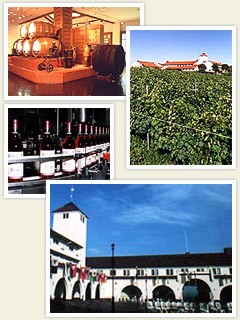
About 2.5 km northeast of the Seishin-chuo subway station, there is a park that strikes a mood of Southern Europe with its hilly terrain. It is here where the Kobe Wine Castle is located. Filled with green vegetation, this park has winemaking equipment, a natural science museum, and a large area for barbeques with everything centered on a wine theme. Facilities include hotel, restaurants, and putter golf course, cycling areas, pasture, outdoor swimming pool, pottery classroom where you can make pottery.
There is a beautiful wine castle with a beautiful contrast between the white walls and red brown roof. At that castle, there are facilities that help to turn the average visitor into a wine professor. When you first enter, you will see a large area with a wooden wine press on exhibit made similar to those seen in France and Germany. Next to the press is a glass room where wine production can be observed. In the cellar there is an area that can be toured where the wine is aged. In the cellar, the low lighting, cool air, and the scent of wood contribute to a relaxed mood.
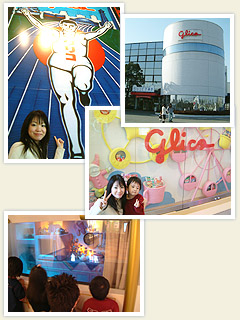
Glicopia Kobe in a factory of Ezaki Glico, a leading confectionery manufacturer. is a confectionery museum where people can enjoy looking at the panels and watching movies showing information about confectionary and its appeal to the culture of eating. With a fascinating history, Glico is famous for its advertising of the Glico runner who eats a piece of candy and is able to run 300 meters. Features include a reproduction of a vending machine with voice and film projector made in 1931, and the history of Glico's giveaway toys. On the factory tour, you can see chocolate and Pretz, a biscuit stick, being made, and you most certainly will not tire of seeing the process of boxes being filled with sweets. The factory supplies the supermarkets and convenience stores of Western Japan with Pretz and Pocky, a biscuit stick covered in a variety of flavors. There is a 3-D theater for kids where they can have an adventure watching a CG animation that appears to be jump out at you. We recommend the toy history corner. Toy giveaways are arranged by period with toys and candy packages from the past that will amaze you.iPlease make the tour reservation by phone beforehand, since capacity is limited.j

